Blue jays, with their dazzling colors, adaptability, and intriguing behaviors, are a truly captivating species. The scientific name of the blue jay is Cyanocitta cristata. Their varied nesting preferences, broad geographical range, and daily activity patterns vividly depict their history.
These charming birds are ubiquitous across many regions of the United States. They intrigue nature enthusiasts with their vivid presence, dynamic vocalizations, and nuanced behaviors. Renowned for their intelligence and adaptability, blue jays can be found in a wide variety of habitats. From dense forests to suburban gardens, they showcase a remarkable capacity to thrive in diverse environments.
The nesting habits of blue jays further demonstrate this inherent flexibility and precision. With much emphasis on food resources and protection for their young.
From foraging for food and engaging in social interactions to defending their territories, their daily routines are a whirl of activity, offering intriguing insights into their behavioral patterns. Seasonal changes also influence their activity levels. With specific periods of the year marked by mating rituals, nest-building, and caregiving responsibilities for their young.
As we delve deeper into understanding where blue jays nest, the states they are most common in, and when they are most active, we will unravel the intricate threads that weave the captivating story of the blue jays’ life.
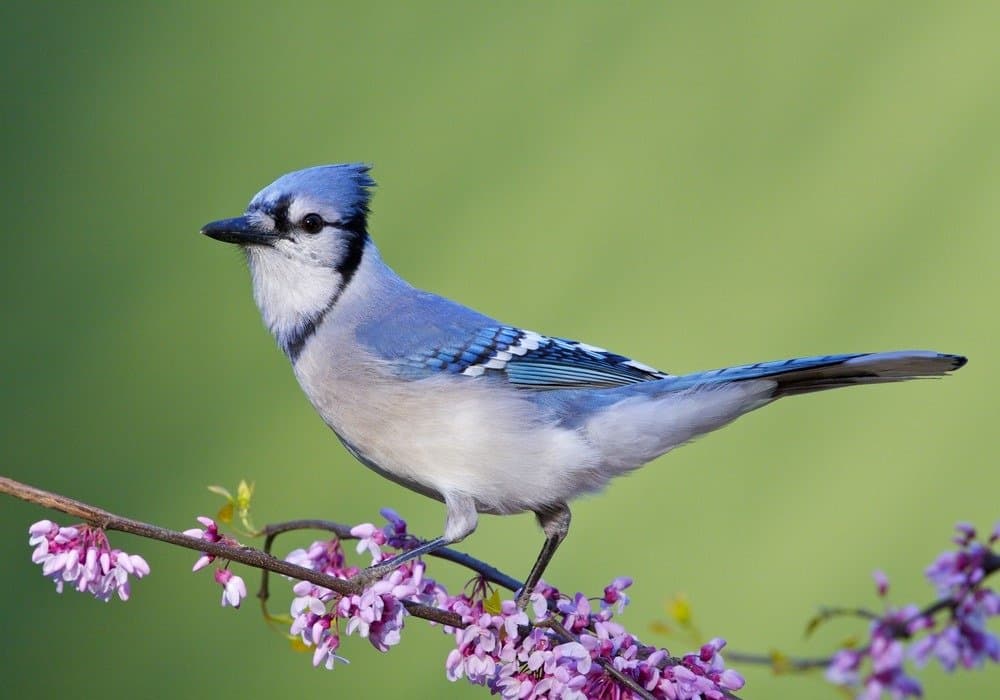
Blue jays are a common bird species across North America.
©Tom Reichner/Shutterstock.com
Blue Jay Nesting Preferences
The magnificent blue jay, recognized for its striking blue plumage and piercing cry, is a widespread avian species across North America. These intelligent birds exhibit particular preferences when selecting the ideal location and environment for nest-making. Let’s divulge the various factors that go into their nesting preferences.
Nesting Location
When blue jays set out to build their nests, they predominantly favor deciduous trees or coniferous species. Including trees such as pine and cedar. However, it’s not uncommon to spot a blue jay nest in a shrub or other robust vegetation. The nests are usually constructed between 10 and 25 feet above the ground. However, in some urbanized environments, they have been known to nest at higher elevations. This preference is for the blue jay’s innate need to balance the accessibility to food and potential threats. The higher elevation affords a wide field of view, protecting against predators while maintaining proximity to ground-level food resources.
Nesting Materials
As for the materials they use, blue jays demonstrate admirable versatility. Nests are generally a cup-shaped construction made from twigs, bark strips, grass, moss, and roots. They even use human-made materials when available, such as paper or string. The inside of the nest is meticulously lined with rootlets and sometimes softened with a layer of moss or other soft materials. This ingenuity provides the nest with a sturdy structure and a comfortable space for incubating eggs.
Food Sources
Interestingly, blue jays’ choice of nesting locations has a profound relationship with their food sources. Primarily omnivorous, blue jays have a diverse diet that includes insects, nuts, seeds, fruits, small vertebrates, and bird eggs. Their chosen nesting locations in deciduous or coniferous trees are usually abundant in these food sources. And particularly so during the breeding and nesting season. The proximity of the nest to these resources minimizes the time and energy spent foraging and reduces exposure to predators.
Blue jays also have a well-documented behavior of storing food, especially acorns, for the winter months. This practice is known as caching. Remarkably, they often select their nesting locations near their caching sites. As this ensures a ready food supply when external resources are scarce during the harsh winter.
It is worth noting that blue jays are resilient birds that have adapted well to urban environments. However, like many species, they prefer areas replicating their natural habitats. Thus, maintaining environments that support their natural nesting preferences and food sources is crucial for preserving these remarkable birds
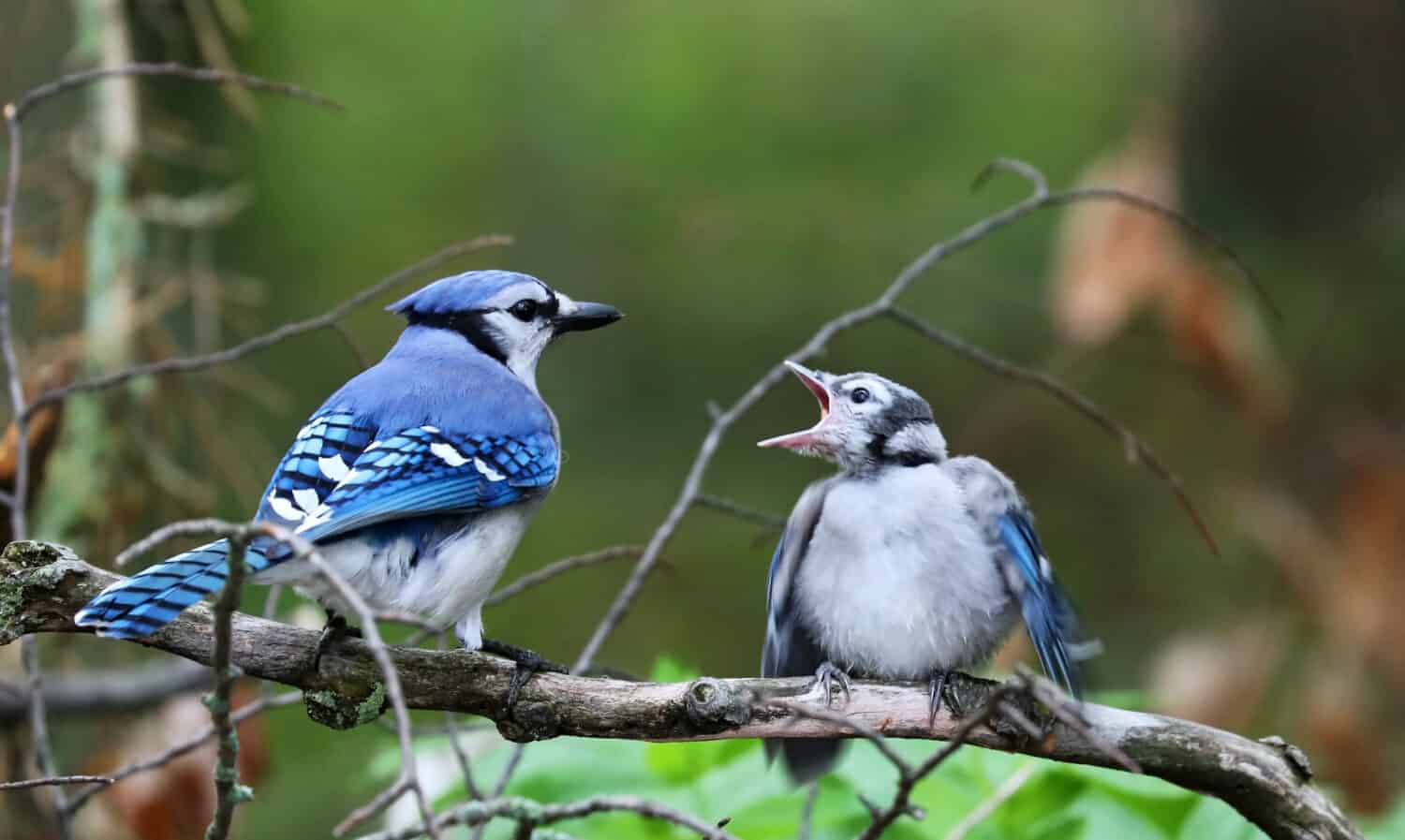
Blue jays construct their nests between 10 and 25 feet above the ground.
©Karel Bock/Shutterstock.com
Blue Jay Nesting Habits
These birds are fascinating creatures, particularly when observing their yearly nesting habits and reproductive behaviors.
The breeding season for blue jays typically begins in mid-March. It can extend until mid-July, depending on the geographical location and the climatic conditions. As monogamous birds, blue jays typically mate for life, adding a compelling depth to their reproductive behaviors. The initial step towards nesting involves courtship rituals, with males and females participating in these elaborate displays. The males often feed the females, demonstrating their suitability as providers for the potential offspring.
Nest construction usually occurs in the early spring, commencing shortly after courtship. The building process is a shared responsibility, with both males and females participating. However, the female tends to lead in the final construction. The pair works in harmony, sourcing twigs, bark strips, grass, and moss for the nest’s structure and softer materials for the lining. Over several days, they construct a robust and well-insulated nest, ideally suited to safeguard their future offspring.
Blue Jay Eggs
Once the nest is ready, the female will lay between 3 to 7 eggs. The eggs, slightly smaller than a chicken’s, exhibit a range of colors. These colors include from olive green to brown, often speckled with dark spots. The female typically lays one egg per day until the clutch is complete. A testament to the precision of nature’s design.
The incubation period lasts approximately 16 to 18 days, during which the female carries out most of the incubating duties. However, the male plays a vital supporting role, standing guard and foraging for food for his partner. Once hatched, the chicks are blind and helpless, depending on their parents for food and protection.
For the next 8 to 12 days, both parents feed and protect the fledglings until they are ready to leave the nest. Remarkably, the fledglings stay with their parents for a further 1 to 2 months. During this time, they learn essential survival skills and social behaviors.
Their nesting habits and reproductive cycle are fine-tuned to the seasons. As this ensures that the young are born when food sources are most abundant, enhancing their chances of survival. Understanding these intricacies of the blue jay’s yearly nesting habits offers insights into the complexity of their behaviors and the depth of their adaptability.
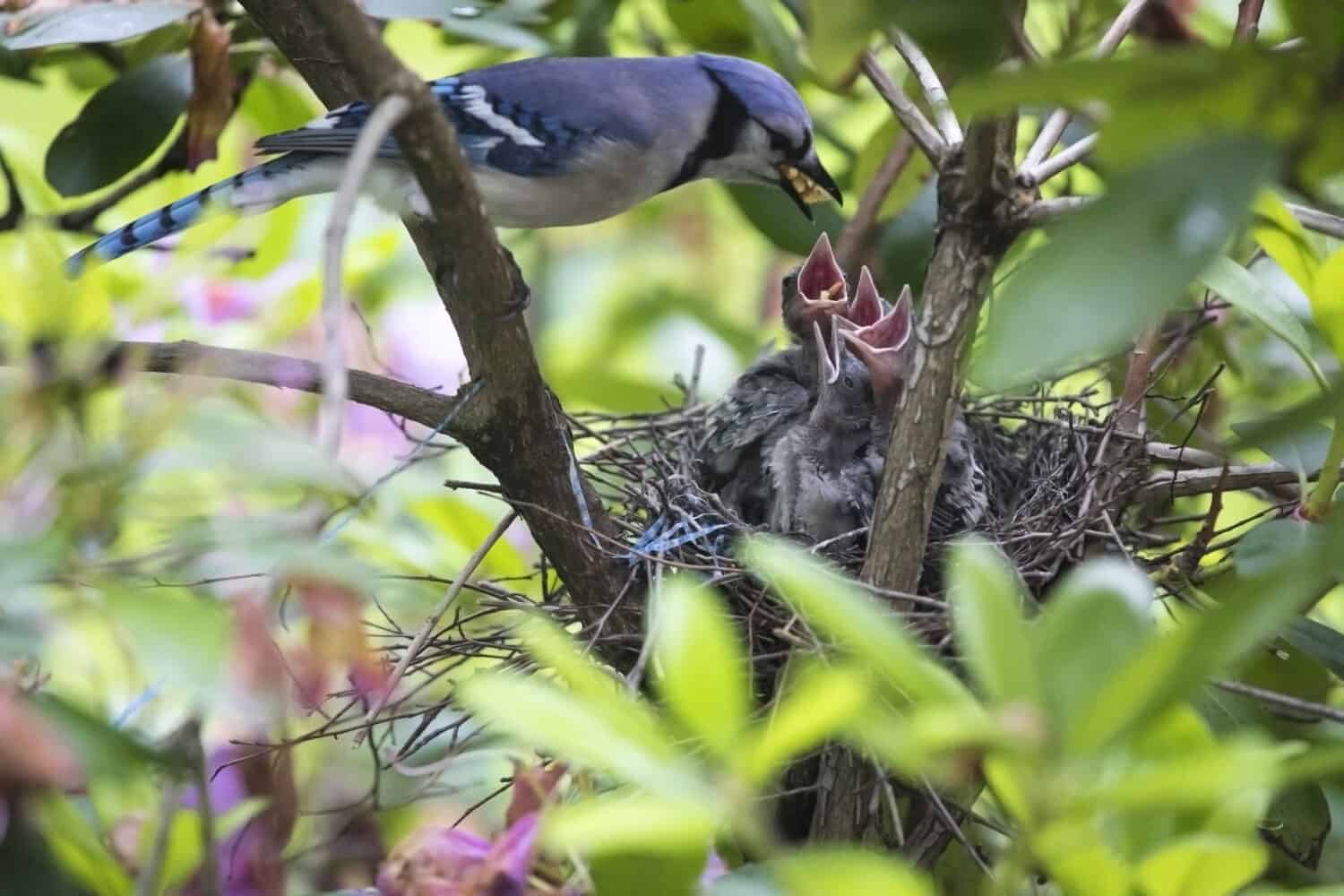
Blue jays build their nests in the early spring.
©Cytis77/Shutterstock.com
When Can You Expect to See Blue Jays Most Active?
Blue jays demonstrate a marked pattern of daily and seasonal activity. Though they are a widespread bird species in North America, observing these cycles can significantly enhance your chances of spotting these magnificent birds in their natural habitat.
Daily Activity Patterns
Like many other diurnal birds, blue jays are most active during the day. Their daily activities commence at sunrise, kicking off with a flurry of vocalizations. This early-morning symphony serves as an avian wake-up call. At this time, blue jays actively forage for food, gathering, and caching supplies to sustain their energy needs throughout the day.
As the day progresses, their activities shift towards social interactions, nest-building, and territorial defense. They continue foraging, albeit at a reduced rate, frequently interspersed with rest and preening periods. By late afternoon, their activity levels tend to decline, with the birds retreating to their nests or roosting spots before sunset.
Yearly Activity Patterns
Throughout the year, the level of blue jay activity varies in tune with the changing seasons. Spring is a hectic time for these birds. As the temperatures warm up, the birds become more vocal and social, and courtship rituals ensue. Following this, building nests and raising young is an energetically demanding period that lasts throughout the spring and into early summer.
The summer months see blue jays engaged in feeding their fledglings, teaching them essential survival skills, and defending their territories against intruders. By late summer, after the young have become independent, the adults often form communal roosts, adding a social dimension to their behaviors.
Winter brings a slowdown in the blue jay’s activity levels. The birds tend to stay closer to their nests or roosting spots, venturing out mainly for foraging. At this time is when their practice of caching food during the warmer months comes into play, providing a reliable source of sustenance during the cold months when food is scarce.
In summary, whether you’re an avid birdwatcher, a casual observer, or a keen researcher, knowing when to expect blue jays to be most active during the day and throughout the year can significantly enhance your understanding and appreciation of these delightful birds.
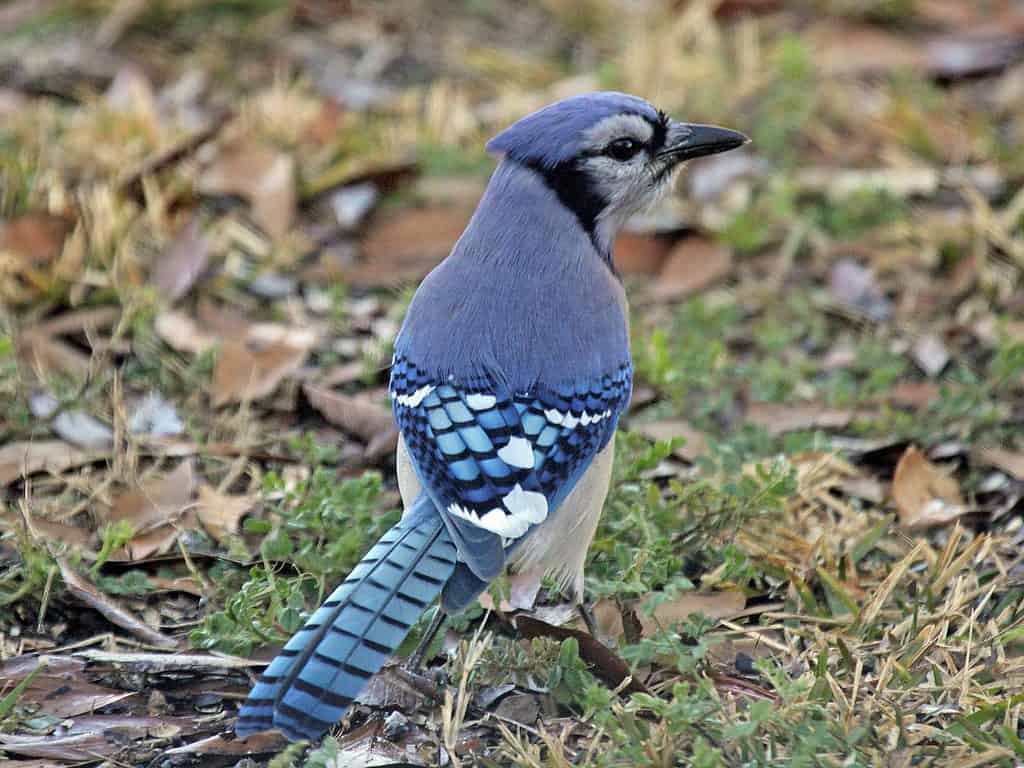
Blue jays are clever foragers.
©DickDaniels (http://theworldbirds.org/), CC BY-SA 3.0 – License
Do Blue Jays Migrate?
Among the many intriguing aspects of their life cycle is migration. Blue jays are partially migratory birds, meaning some populations migrate while others remain residents throughout the year.
The same factors determining whether a blue jay will migrate have yet to be entirely understood and are still subject to ongoing research. It is a mix of the bird’s age, the availability of food resources, and the harshness of the winter season. Most blue jays in the southern part of their range tend to remain in their territory all year round. In contrast, a portion of the population found in the northern range undertakes an annual migration.
When they do migrate, blue jays usually begin their journey in late September and continue through October. The flight paths blue jays take during their migration are determined by the geographical features of their environment, with most birds flying overland along a broad front rather than following narrow corridors. Unlike many songbirds, they mostly fly in large, loose flocks during the day.
Regarding their migration destination, blue jays typically travel south for the winter. The birds from the northern parts of North America, such as Canada and the northern United States, will often move to the southern United States or Mexico. The climate is milder further south, and food resources are abundant. Come spring, they return to their original territories to breed and nest.
However, it’s essential to highlight that not all blue jays migrate every year, even within populations known for migration. They display ‘irruptive’ migration, meaning their migratory patterns can vary considerably yearly, depending on factors like weather and food supply. Some years see vast numbers migrating, while others have relatively few.

Not all blue jays migrate during the winter.
©Matthew Jolley/Shutterstock.com
Which States in the US Have the Highest Blue Jay Populations?
These vibrant birds have a broad geographical range across North America. However, certain regions are notably rich in blue jay populations, offering bird enthusiasts ample opportunity to observe these delightful creatures.
The United States, particularly the eastern and central states, is a prime habitat for blue jays, with these birds being a common sight from Texas to Florida and up to Maine. As for specific states that host the most robust blue jay populations, three stand out.
1. Florida
Florida, for instance, has an exceptionally high population of blue jays. The state’s mild climate, abundant forested areas, and plentiful food sources make it an ideal environment for these birds. Interestingly, Florida is also home to a unique blue jay subspecies, the Florida Blue Jay (Cyanocitta cristata semplei), which tends to be slightly smaller and darker than its northern counterparts.
2. Texas
Texas also hosts a significant population of blue jays. The state’s diverse habitats, ranging from thick woods to suburban areas, provide an array of suitable nesting and feeding areas for these birds. The blue jay populations in Texas appear to be resident year-round, as opposed to those in the northern parts of their range that display partial migration.
3. New York
New York and other northeastern states provide excellent habitats for blue jays, especially during the breeding season. These regions’ deciduous and mixed forests offer ideal nesting sites. At the same time, the abundance of acorns, seeds, and insects cater to the blue jays’ diverse diet.
It’s important to note, though, that blue jays are also a common sight in many other US states. From suburban gardens to public parks and forested areas, these birds have adapted to a wide range of environments, thus enhancing their chances of survival and propagation.
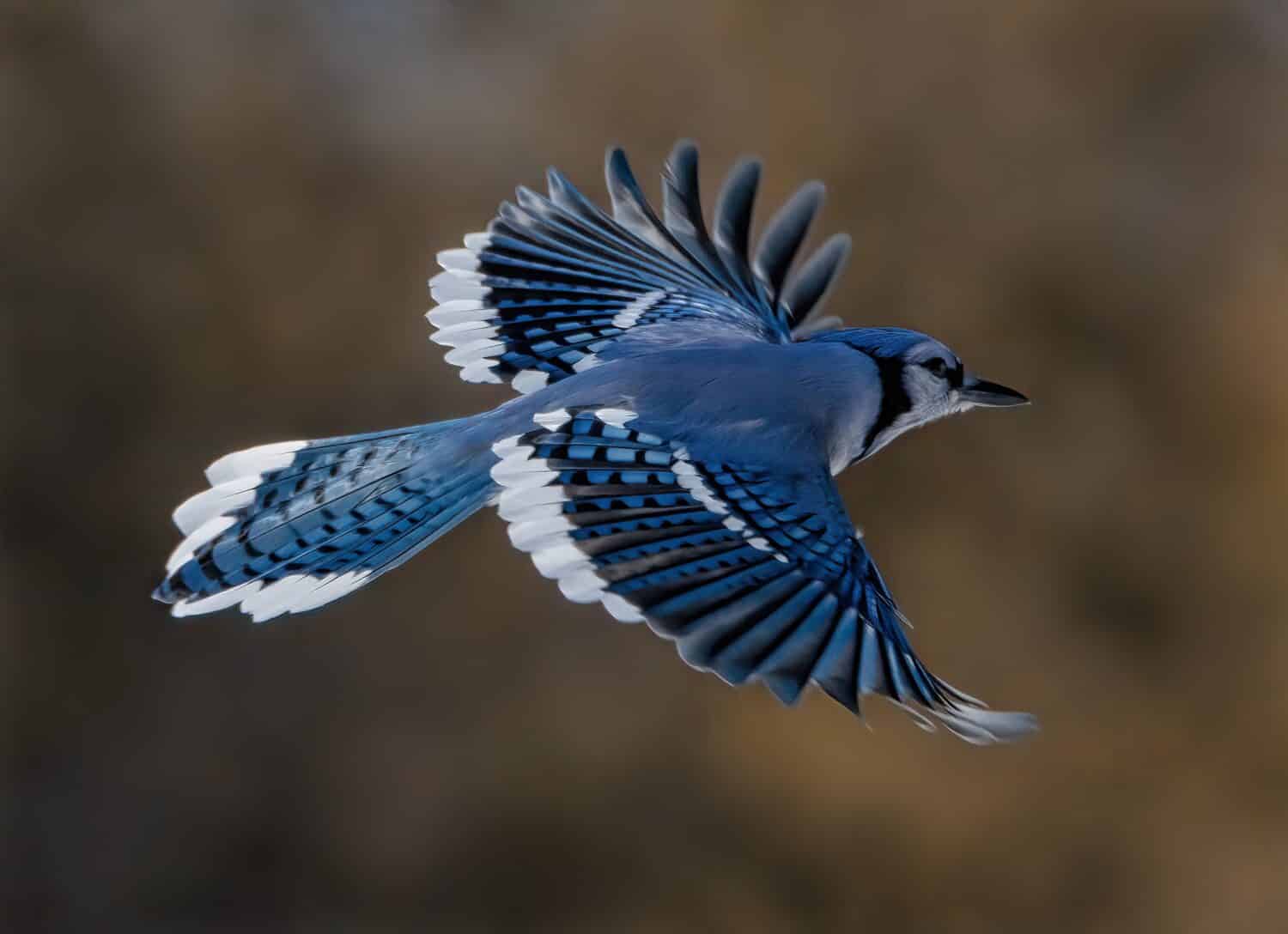
Blue jays have distinctive calls and intriguing behaviors, which easily distinguish them from other birds.
©Fiona M. Donnelly/Shutterstock.com
Conclusion
In the vast tapestry of the avian world, the blue jay shines brightly with its radiant coloration and bold vocalizations. This intriguing creature, native to North America, offers an enriching case study into bird behaviors and habitat preferences. These birds are not only captivating due to their vibrant colors but also for their intriguing habits and adaptability, both in their nesting preferences and geographical distribution.
Blue Jays Take Great Care in Their Nests
Blue jays, quite the architectural aficionados of the bird world, show an unmistakable preference for deciduous or coniferous trees when it comes to nesting. They carefully select a site within the crotch or thick outer branches of a tree and favor positions 10-25 feet above the ground, maintaining a safe distance from potential predators. However, their adaptability shines through when faced with urban or suburban environments, where they nest in man-made structures, showcasing remarkable flexibility in their nesting habits.
The blue jay nest, a marvel of avian craftsmanship, is meticulously woven with twigs, leaves, rootlets, and grass. Occasionally, a touch of mud is added to the mix, providing additional stability to the nest. This diligent construction leads to a sturdy cup-shaped design that offers a haven for their eggs and, later, their fledglings.
Blue Jays Are Widespread
Blue jays are located all across the United States. However, they have an especially prominent presence in certain states. From the sun-dappled landscapes of Florida to the diverse expanses of Texas and the verdant forests of New York, these regions offer an ideal mix of nesting spots and rich food sources that cater to the blue jays’ eclectic diet. This geographical distribution, while indicative of their adaptability, also represents the varying regional characteristics that align with the survival requirements of these birds.
The blue jay, with its dazzling colors, distinctive calls, and intriguing behaviors, adds a splash of color to the world. Their adaptability and broad geographical range make them a delight for birdwatchers and nature enthusiasts across their habitat range, contributing to the rich avian biodiversity of North America.
The photo featured at the top of this post is © Fiona M. Donnelly/Shutterstock.com
Thank you for reading! Have some feedback for us? Contact the AZ Animals editorial team.






